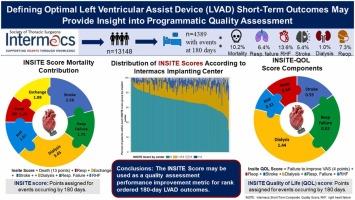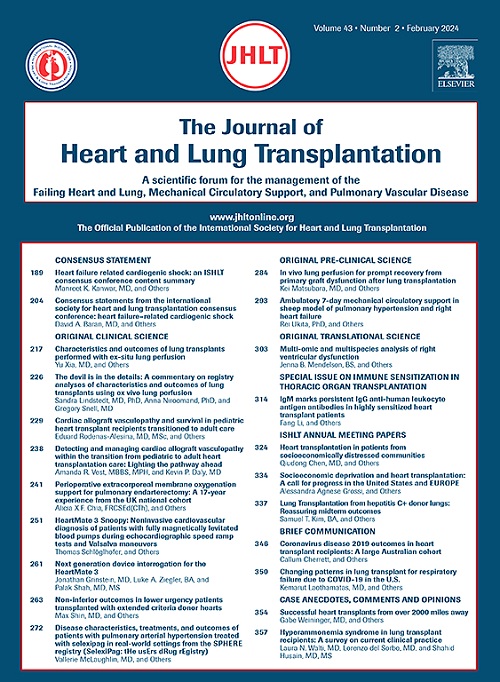定义左心室辅助装置的最佳短期疗效可为项目质量评估提供启示。
IF 6.4
1区 医学
Q1 CARDIAC & CARDIOVASCULAR SYSTEMS
引用次数: 0
摘要
背景:左心室辅助装置(LVAD)植入术后,患者围手术期结果存在很大差异。需要一种将死亡率、不良事件(AEs)和患者报告结果整合在一起的围手术期多维工具来协助质量改进措施:方法:研究了胸外科医师协会 Intermacs 登记处接受 HeartMate 3 LVAD 植入术的患者(2017 年 1 月 1 日至 2024 年 1 月 31 日)。将 AE 作为 180 天内死亡率的时变协变量进行了 Cox 比例危险多变量分析,得出了 Intermacs 短期综合质量 (INSITE) 评分,反映了每种 AE 导致的死亡率调整危险比 (HR),并采用了全球排名方法。对于 6 个月时仍存活并接受支持的患者,采用多变量逻辑回归(几率比,OR)来检验 AE 对 180 天内健康相关生活质量 (QOL) 的影响,INSITE-QOL 评分反映了这一影响。在 QOL 分析中,视觉模拟量表(VAS)与基线相比未达到≥1 分增长是一个事件:在 13,148 名患者中,4,389 人(33.4%)在 180 天内至少出现一次 AE 或死亡。中风(存活率:HR 13.1;QOL:HR 1.7)、透析(存活率:HR 31.4;QOL:HR 4.2)、长期呼吸衰竭(存活率:HR 5.7;QOL:HR 2.3)、再次手术(存活率:HR 3.4;QOL:HR 1.6)和右心衰竭(存活率:5.0;QOL:HR 1.4)导致了死亡率和 180 天内 QOL 无法改善(所有 p 均为 0):LVAD 术后并发症对死亡率和生活质量的影响各不相同,因此可以制定全球排名结果评分。鉴于 180 天 AE 对死亡率的高危害性,旨在减少早期并发症的特定中心质量干预为改善长期生存和 QOL 提供了最大的机会。本文章由计算机程序翻译,如有差异,请以英文原文为准。

Defining optimal left ventricular assist device short-term outcomes may provide insight into programmatic quality assessment
Background
Patients have substantial variability in perioperative outcomes after left ventricular assist device (LVAD) implant. A perioperative multidimensional tool integrating mortality, adverse events (AEs), and patient-reported outcomes to assist in quality improvement initiatives is needed.
Methods
Patients undergoing HeartMate 3 LVAD implant (January 1, 2017 to January 31, 2024) in the Society of Thoracic Surgeons’ Intermacs registry were studied. Cox proportional hazard multivariable analyses incorporating AEs as time-varying covariates for mortality out to 180 days was used to generate the INtermacs Short term composITE quality score (INSITE score derivation), reflecting the adjusted hazard ratio (HR) for mortality contributed by each AE, applying the global ranking methodology. In those alive and on support at 6 months, multivariable logistic regression (odds ratio) was used to examine the impact of AEs on health-related quality of life (QOL) at 180 days, captured through the INSITE-QOL score. Failure to achieve ≥1 point increase in visual analog scale from baseline was the event.
Results
Of 13,148 patients, 4,389 (33.4%) suffered at least 1 AE or death through 180 days. Stroke (survival: HR 13.1; QOL: HR 1.7), dialysis (survival: HR 31.4; QOL: HR 4.2), prolonged respiratory failure (survival: HR 5.7; QOL: HR 2.3), reoperation (survival: HR 3.4; QOL: HR 1.6), and right heart failure (survival: 5.0; QOL: HR 1.4), contributed to both mortality and failure to improve QOL at 180 days (all p < 0.05). The median INSITE and INSITE-QOL scores were 0.0 [0.0, 1.6] and 0.0 [0.0, 0.0], respectively. At 9.4% (n = 17) of centers, a high INSITE score (≥13) was present in 15% of patients, while the top 25% of centers had perfect INSITE-QOL scores in at least 75% of patients.
Conclusions
AEs after LVAD confer differential impact on mortality and QOL, enabling the development of global rank outcome scores. Given the high mortality hazard conferred by 180-day AEs, center-specific quality interventions aimed at reducing early complications provide the greatest opportunity to improve long-term survival and QOL.
求助全文
通过发布文献求助,成功后即可免费获取论文全文。
去求助
来源期刊
CiteScore
10.10
自引率
6.70%
发文量
1667
审稿时长
69 days
期刊介绍:
The Journal of Heart and Lung Transplantation, the official publication of the International Society for Heart and Lung Transplantation, brings readers essential scholarly and timely information in the field of cardio-pulmonary transplantation, mechanical and biological support of the failing heart, advanced lung disease (including pulmonary vascular disease) and cell replacement therapy. Importantly, the journal also serves as a medium of communication of pre-clinical sciences in all these rapidly expanding areas.

 求助内容:
求助内容: 应助结果提醒方式:
应助结果提醒方式:


